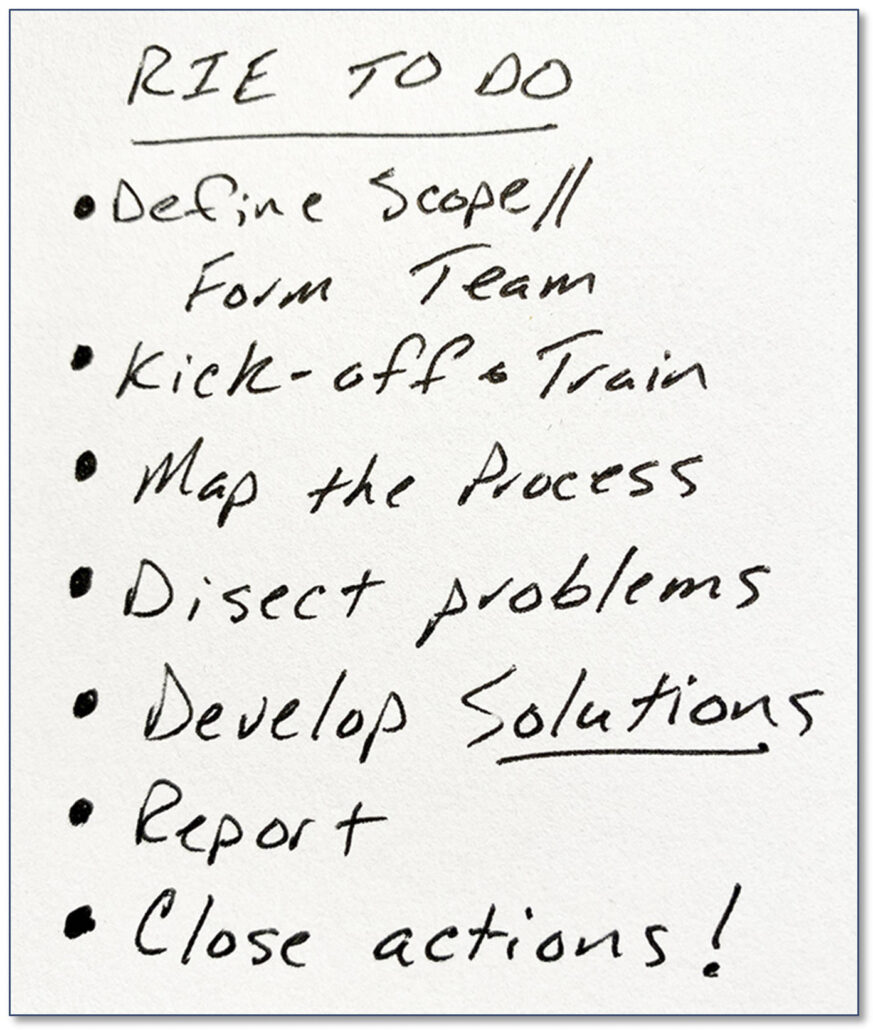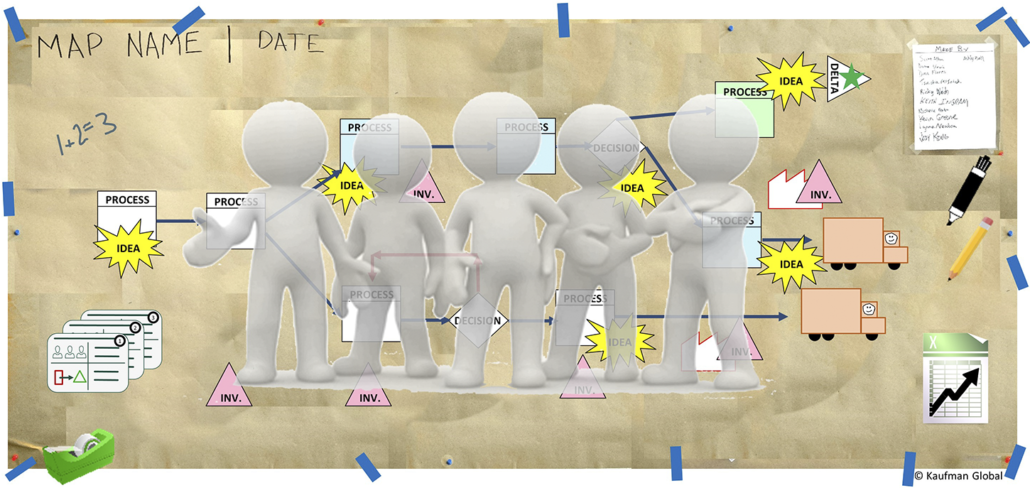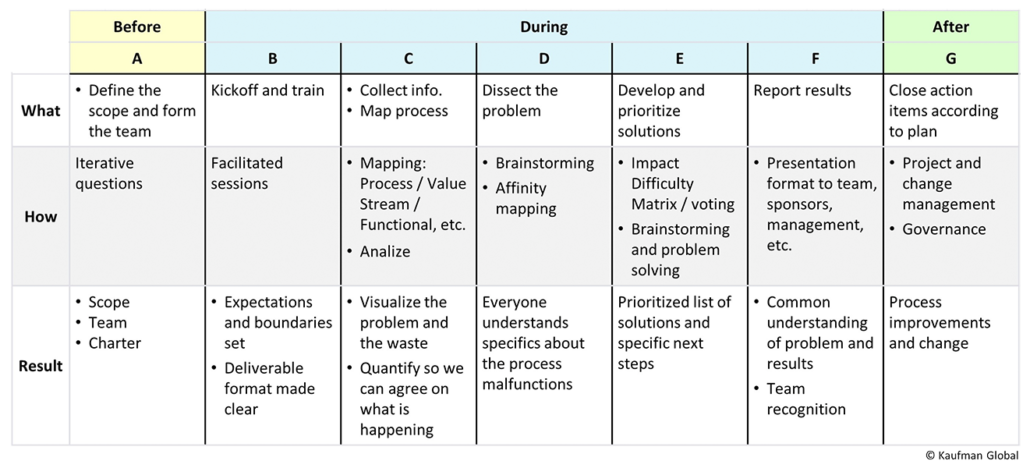Rapid Improvement Event (RIE) Fundamentals
by Jerry Timpson
The Rapid Improvement Event (RIE) is a great way to solve nagging process problems. Best results happen where flexibility and fundamentals meet.

Rapid Improvement Event Checklist
Origins of the Rapid Improvement Event (RIE)
Using teams to solve problems is not new. When the Toyota Production System and Lean started to expand outside of Japan in the 1970s, a technique known as the Kaizen Event became one of the more formal approaches to fixing process problems. It started in factories with a production focus. Over time, this structured team-based problem solving method has been applied to all functions and operational areas. Because of this, the form has adapted and evolved. Here, we outline some of the basics with insights on how to get the most from your efforts.
What Do We Call This?
The original term is “Kaizen Event.” At Kaufman Global prefer Rapid Improvement Event (RIE) because it describes expected outcomes and frankly this label translate better across the global landscape. It has been labeled many things: Rapid Process Improvement, Accelerated Change Process, Process Improvement Event. The point is, you can call it whatever you want to. But before you start naming it something new and special, keep in mind that standards (like names) are important because they take the guesswork out of what something means or what something does.

Process maps are a common element of Rapid Improvement Events
The Traditional Approach
The idea was – and this still works today – that you have a factory running along, churning out parts. Then a nagging problem related to low productivity or poor quality gets in the way. Something must be done! It is decided that a Rapid Improvement Event (aka Kaizen Event) could finally solve the problem. So, a team is formed and everyone comes together starting first thing Monday morning. They work all week in perfect harmony and then give a final report on Friday afternoon. There is no controversy. The problem is solved – forever. Management loves it. Everyone celebrates…
It could happen.
Things Change
When it comes to continuous improvement, following tradition blindly can be a dangerous thing. Ultimately, tradition needs to evolve to take into consideration changes that confront us today, like…
- We want to apply this technique to something other than a factory, for example; hospitals, purchasing, sales and operations planning, IT, human resources, a chemical plant, etc. You get the idea.
- The team is not always located in one place. People need to come in from other buildings, cities or countries.
- The problem is not about parts, it is about services, information, policy, or logistics.
Anything might make us want to use a team to fix a process. If we maintain certain standards and yet are flexible enough to adapt to new environments, we can get better results in a more predictable way.
Rapid Improvement Event Fundamentals
The standard steps are:
A. Define the scope and form the team
B. Kick off the event and train the team in the basics (Lean, waste, problem solving, teamwork)
C. Map the process and collect data
D. Dissect the problem into its elements
E. Develop and prioritize solutions
F. Report results
G. Close action items according to plan
This is the general flow of any Rapid Improvement Event. I can’t tell you if it is 3 days or 5 days. It depends on the scope of the problem and expected results. I can tell you if it’s less than a couple of days work, or more than 5 days, it’s probably not a RIE. Here are some general rules you can use to dial this in.
Define the problem and form the team. These two elements should be thought-through together until the scope and team fit naturally. You want individuals who can come together for a few days and really solve a specific problem. By “really solve,” I mean deliver something beyond suggested solutions in PowerPoint, or job roles that have been modified, but not agreed to, outside of the event. You must create a scope for the workshop where a well-formed team can do something impactful inside of a week.
First think about the problem and then about the people who might know the most about it. The team should have people who work directly inside the process and upstream and downstream from it. In other words; users, suppliers and customers. Then, set a reasonable scope by asking: Could 5 to 9 people get good results in 3 to 5 days? If the answer is yes, then the scope works. If it takes fewer people less time, then the scope is too narrow and could be addressed in a simpler way. The opposite; if it takes more than 5 to 9 people or longer than 5 days, then the problem is too big and it should be solved via another approach – a project for example.
Once you have the team and scope resolved, the rest can fall into place according to the following table:

Basic steps for any Rapid Improvement Event
Keeping The Rapid Improvement Event On Track
A Rapid Improvement Event has a specific sequence and tactical steps. However a certain mindset and attitude helps keep things flowing.
Speed and accuracy – Whatever you happen to be working with or on, try to laser in on how a change will improve speed and accuracy. This will help lead to results that include: better safety, shorter lead times, faster cycle times and better quality.
Be flexible in the techniques you use to sort things out. Don’t just rely on the traditional maps and consensus-building tools that are normally used in a Kaizen. Figure out what will be most effective based on the problem and process you are working on.
Be curious. Real progress happens when we acknowledge that the team knows more about the process than any one designated “expert” or leader. Be open to a constructive discussion and differing viewpoints about why certain things happen. Visualize the issues and data so that everyone is working with the same set of facts. When you get consensus on the current state and problems, that is when the team can really take steps to make improvements.
Let the team do the work. The facilitator’s job is to have the team do the work of discovery and design. Leadership and management’s job is to validate the scope but empower the team do the work, remove barriers and cheer lead. Ownership of the solution must ultimately rest with the team to ensure sustainability.
Avoid piling on – If you find that the RIE starts attracting a lot of attention and the roster of participants begins to grow, be cautious. This is more like a project design workshop and that has a whole different complexion. There is nothing wrong with doing these types of workshops, except they require a different form of facilitation and will not solve process problems. Project design workshops get people energized and set up expectations and a plan to take significant next steps.
Follow through – Before you start, have an idea for how to keep leadership engaged and close on any lagging actions from the event. This often means some form of governance coupled with 30-60-90 day action plans.
Conclusion
As the RIE format has expanded beyond the manufacturing floor, the greatest potential for problems is a lack of coordination between functions and departments. Few shared metrics and organizational disconnects, where silos are more powerful than value streams, are common challenges. Establishing basic rules of engagement, involving the right leadership and a good charter will help make sure things stay on track during, and more importantly, after the workshop.
Kaufman Global conducts Rapid Improvement Events everywhere in the world. We also teach organizations and change agents how to facilitate events and workshops.
Contact us to learn more. Additional information can be found here:
Developing Operational Excellence Leaders White Paper

Jerry Timpson is a co-founder and President of Kaufman Global. He is a change agent with focus on implementation, leadership and employee engagement. You can connect with Jerry on LinkedIn.


